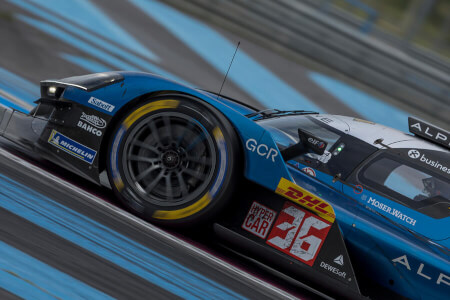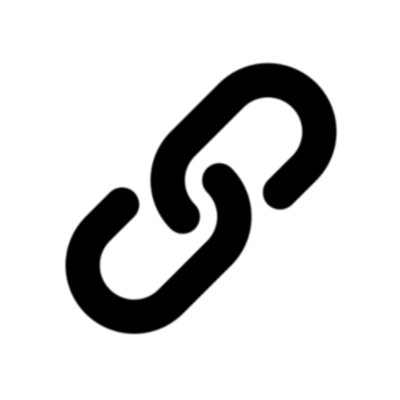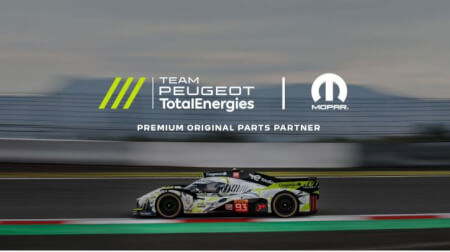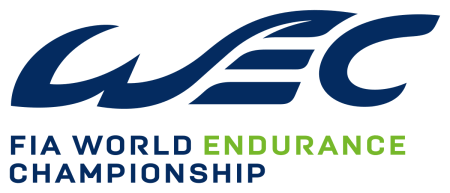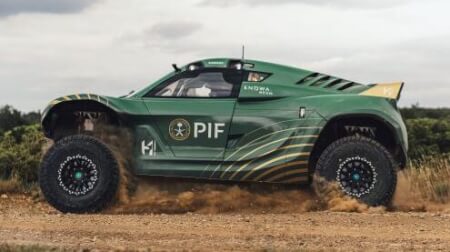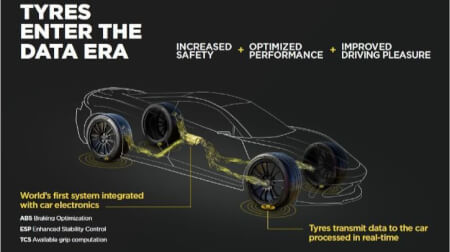June 5th 2025
Michelin GTP/Hypercar tires set for final validation test
Michelin’s new Hypercar and GTP tires for the 2026 FIA WEC and IMSA seasons are almost ready to roll. The French supplier has one final validation test at Watkins Glen to complete later this month, before the design of its new slicks is finalized and production commences over the summer.
It’s been a long, tough road for Michelin, which began work on its new rubber way back in 2022. It was forced to delay the introduction of its new range by a year from the originally planned debut in 2025 due to adverse weather affecting the dry tire test program and the lack of availability of a key material. However, it believes that with an additional year of development work, its new tires will be worth the wait for the manufacturers in play.
At first glance, Michelin’s 2026 tires are immediately identifiable. They feature a bold, striking look courtesy of an unusual visible tread pattern, symbolizing the strides forward it has made in sustainability. (Handily, it will also make it easier to spot which tires are brand-new when being placed on a car at a stop!)
At the global reveal of these tires, held behind closed doors at Paul Ricard last month, sustainability was the big talking point. Michelin is eager to celebrate the achievement of its ambitious targets in this area. The range incorporates 50 percent renewable and recycled materials, up from just over 30 percent in the current tires used in Hypercar and GTP.
This has been achieved by developing and utilizing a blend of elastomers (natural rubber), fillers (recovered carbon black), and plasticizers (bio-oils, bio-resins, and recycled steel), building on the foundations laid by the racing demonstrator it unveiled in 2024, which incorporates 71 percent renewable materials. Remarkably, only two materials didn't make the cut from the demonstrator: recycled styrene and PET plastics (Polyethylene terephthalate).
This has been achieved by developing and utilizing a blend of elastomers (natural rubber), fillers (recovered carbon black), and plasticizers (bio-oils, bio-resins, and recycled steel), building on the foundations laid by the racing demonstrator it unveiled in 2024, which incorporates 71 percent renewable materials. Remarkably, only two materials didn't make the cut from the demonstrator: recycled styrene and PET plastics (Polyethylene terephthalate).
Going further, Michelin will begin recycling the Hypercar tires used in the FIA World Endurance Championship by 2026, too. Each tire used in competition will be broken down through pyrolysis (decomposition via high temperatures) using a process developed in partnership with the Swedish organization Enviro. Carbon black will be recovered from this process and used to create new materials for use in passenger car tires.
This serves as a boost to Michelin's wider corporate roadmap for sustainability, in which it is committed to achieving a 40 percent renewable and recycled material milestone across its entire range by 2030 (up from 31 percent today) and 100 per cent by 2050.
Beyond that, Michelin is looking to improve the capabilities of its Hypercar tires with this new range of slicks. Most importantly, analysis from testing has confirmed that the tires will reduce the time it takes to reach optimal temperatures after exiting the pits.
Currently, in the absence of tire warmers, Michelin says teams are losing around five to six seconds on the softs and 10 to 13 seconds on the mediums on out laps when racing on standard grand prix circuits. This is therefore welcome progress for the teams and drivers, particularly in the FIA WEC, as struggles with tire warmup and temperature management have been hot-button topics on and off since the tire warmer ban was first enforced in the world championship back in 2023.
Impressively, despite the increase in sustainable materials used, Michelin also believes its tires tick three additional boxes: the wear rate has been improved, consistency has increased, and they produce similar, if not marginally faster, lap times. However, “the aim was not to go quicker, because of Balance of Performance,” Pierre Alves, Michelin Motorsport's sports car operational manager, points out.
"When we first began testing, we were exploring a range of potential sustainable materials, and we had feedback from drivers that the tires felt the same, and for us, that ticked a box; that's what we want. What we want is to have tires that perform well on all tires and all tracks," he explains. "When we tested in Qatar, we found something that worked well for warm-up and produced very good lap times, but the wear wasn't as good. We had to find a compromise.
"When we first began testing, we were exploring a range of potential sustainable materials, and we had feedback from drivers that the tires felt the same, and for us, that ticked a box; that's what we want. What we want is to have tires that perform well on all tires and all tracks," he explains. "When we tested in Qatar, we found something that worked well for warm-up and produced very good lap times, but the wear wasn't as good. We had to find a compromise.
"We don't really consider these 'soft,' 'medium' or 'hard' compounds; they are 'cold,' 'medium' and 'hot' really. We have to cater for different types of cars (LMH, LMDh, hybrid and non-hybrid), so we need a good crossover from one spec to another.”
In terms of durability, the potential to use the tires for up to five consecutive stints at Le Mans (conditions permitting) with "no compromise in performance" is targeted after year one.
"We need the status quo next year, then after that, once we have knowledge and data, the aim is to reduce the number of tires used during events," Alves adds.
What could this look like in practice? A double stint format for six-hour races may become the norm, with each team handed three sets instead of four and a half like they are now in the FIA WEC.
Crucially, though, in the WEC (not in IMSA), the plan is to continue utilizing two of the three specifications at each WEC race aside from Le Mans, where all three are available. There is also an ongoing discussion about the number of specs taken to Daytona.
To develop these tires, Michelin has had to work around the restrictions on track testing imposed by the rule-makers, which have limited it to two to three days a year.
Thus, in addition to visiting key circuits around the world, such as COTA, Paul Ricard, Portimao, Qatar, Road Atlanta, Sebring, Spa and Watkins Glen during the development process of the 2026 compounds, Michelin has utilized cutting-edge simulation tools to conduct virtual tests with tire models.
"At every stage, we create a virtual tire," notes Philippe Tramond, Michelin Motorsport's technical director. "It lets us assess the car's dynamics, thermal effects and performance consistency over time. Michelin has some of the most advanced simulation software in the sector; we can go very deep into key data.”
It has also made use of two state-of-the-art tire testing machines in Clermont-Ferrand, France: a rolling machine which can test slip angles and a "record" machine designed in-house. The latter, in particular, has proven to be vital. It can simulate the forces and speeds of specific circuit layouts on tires using real-world car setup data. "We try to reach the limit of the tire until it loses pressure, and we use this before every race as well as in development," Alves says.
The track testing phase proved complex. A combination of adverse weather, which disrupted a key test in Portimao, and supply issues for key materials led to a year-long delay in the introduction of the new rubber.
"We started thinking of what the specification would be at the end of 2022," Alves says. "We had a loop in Portimao in March of 2023, but it wasn't successful because of the rain. That's why it took nearly two years of development work, because we are not allowed to test whenever we want.”
Nevertheless, Michelin has persisted, making the most of each opportunity for dry running. Although the LMH and LMDh manufacturers are not obliged to take part, all of them are handed an open invitation to attend the tire tests and have (unsurprisingly) welcomed the opportunities with open arms. For instance, on-site at Paul Ricard for the final European validation test, Alpine, BMW, Cadillac, Ferrari, Porsche, and Toyota were present and received a run plan to execute.
Running with a single base setup throughout the day, the drivers were asked to complete a mixture of long and short runs over 10 hours, using three prototype specs with the finalized casing and different compounds, as well as a reference tire, to help Michelin fine-tune its options.
There is one more test to come at Watkins Glen later this month before a design freeze in July, ahead of the final decision on which compounds will make the cut. Production will then get underway and ramp up from September to December ahead of the 2026 season. It's a mammoth task, and the time frame is tight.
To put the numbers into perspective, Michelin produces 30,000 top-class prototype tires a year across its IMSA, FIA WEC and test programs, and on average, takes 2,000 tires to each event.
During the production phase, a virtual tire model will become available to manufacturers for simulator testing. Michelin will also take its new products to the IMSA-sanctioned tests in Daytona in November, ahead of their global race debut at the Rolex 24 next January.
The job is by no means complete when the new season starts, either. Michelin will continue to work with each manufacturer at every step and begin planning for the future. In the background, it has been developing a new wet compound, which will debut once it gets through its current stock. The tender process for Hypercar tires from 2030 is also expected to commence soon, following the expected announcement at Le Mans next week that the ruleset is being extended into the next decade. By planning this early, Michelin and/or any other competitors for the supply contract will have ample time to develop a range.
"The plan is to keep these tires in place for two or three years, with the potential for a new range by 2029. We are already in discussion to introduce a new tire line by 2030 if the category is going to be extended and if Michelin is still the sole supplier for endurance," Tramond concludes. "We have already thought about what we could do to push the level even higher."
For more information: www.racer.com
For more Industry News, please Click Here
For more information: www.racer.com
For more Industry News, please Click Here
